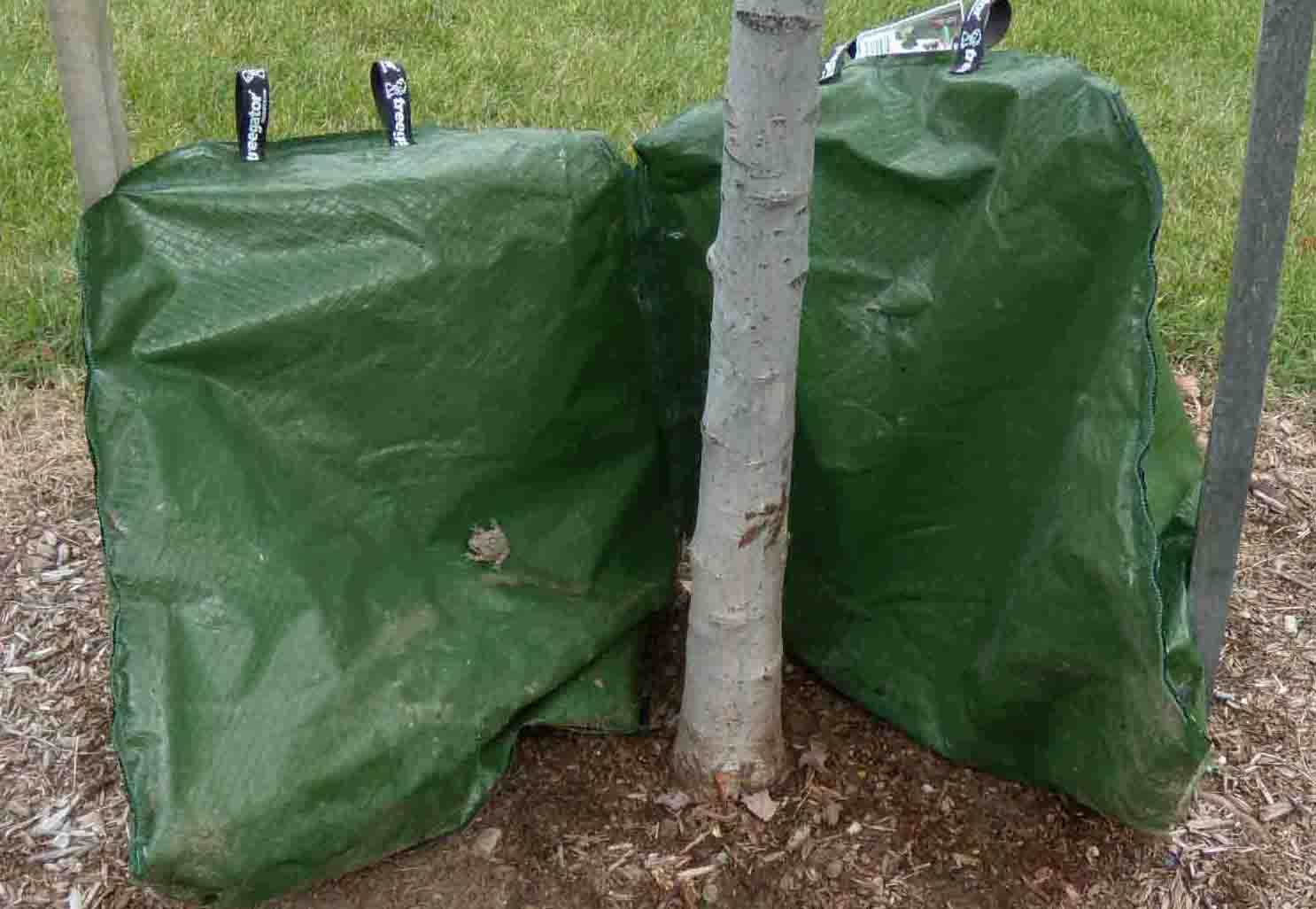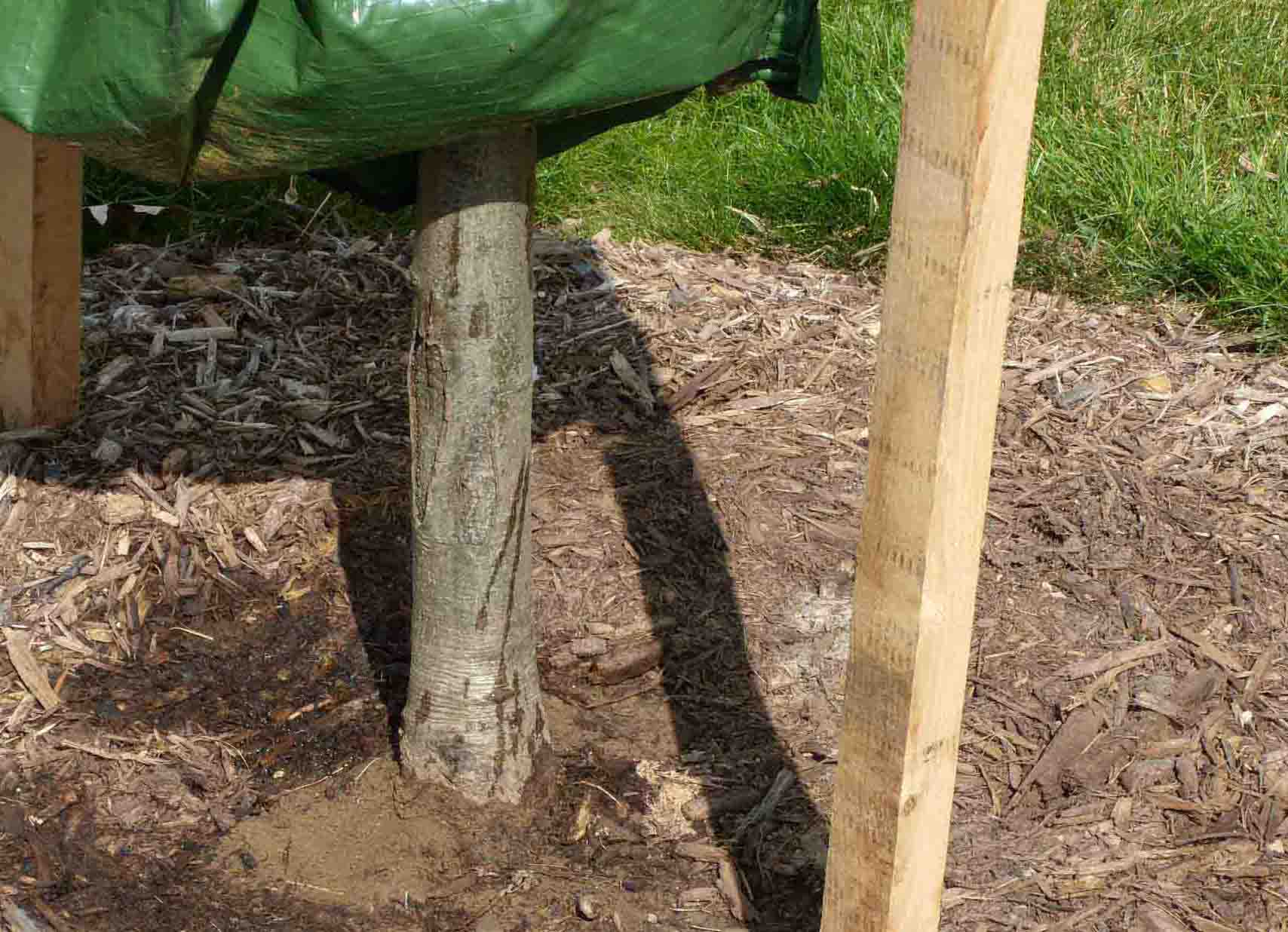Following up on Linda’s earlier comments about potential problems with TreeGators, my summer interns and I did a random spot check of about 150 TreeGators currently in use on the MSU campus. As background, MSU Landscape Services plants about 1,200 trees and shrubs each year. All newly-planted trees which are not on an automatic irrigation system are fitted with one or two TreeGators, which are filled from a water wagon every week or every two weeks, depending on weather. Conifers and multi-stemmed trees are fitted with Tree-Tubes, another style of irrigation bag that fits like an inner-tube around the base of a tree. At MSU irrigation bags are usually left on trees during the first growing season. Presnetly there are over 1,000 irrigation bags in use on the MSU campus.
During our spot-check, we found few items I would consider to be a major concern. We found 25 trees with mold or saprophytic fungi growing in the mulch under the bags. While unsightly, these are unlikely to cause major tree problems and will be gone once the bags are removed and the mulch is exposed to air. All but a handful of the bags had drained properly and therefore the trunks on most of the trees were dry – eliminating the potential problems that Linda noted about the trunks remaining constantly wet. TreeGators are designed to drain in 4-5 hours. Therefore, on a once every two weeks or once a week filling-cycle, they should be full only 1.5% to 3% of the time. TreeGators that are not draining between fill-ups should be checked for clogs and have a new hole punched, if needed.
It is worth noting that the dark protected space between the irrigation bag and the trunk can provide habitat for various organisms. We found an assortment or earwigs, spiders, and millipedes; plus one tree frog and one dead bird. The major concern that we found, however, were gypsy moth egg masses (photo 1), which occurred on 14 trees. Gypsy moths, which are serious defoliators of trees in the eastern US, like to lay their egg masses in protected locations on tree trunks so the inside of the Gator bags makes a handy hideout. Once found, egg masses are fairly easy to remove, though killing the eggs takes some effort.
While there is a potential for pests to hide out under irrigation bags, I think the benefits of irrigating with TreeGators outweigh the potential negatives. This is especially true in our heavy Midwestern soils where it is impossible to deliver any meaningful amount of water to a newly planted tree in a reasonable time without run-off. MSU Campus Arborist Paul Swartz reported less than 0.5% mortality out of over 1,000 newly planted trees on campus last year. The high success rate is attributable to good overall tree management by Landscape Services, including supplemental irrigation using the irrigation bags. The take home message from our survey is that tree care workers need to check bags at each filling to ensure that bags are draining properly and to lift up the bags and inspect for signs of pests or other issues.

TreeGators on MSU Campus

Tree frog inside TreeGator

TreeGators should drain in 4-5 hours when working properly.

Cause for concern. Gypsy moth egg mass on trunk.
Wow, Bert, I'd forgotten about the gypsy moth issue. When we lived in Buffalo we were all very careful not to use tree wraps, etc. just for this reason. Yet another cautionary tale!
I have found that the doughnut style gator bags offer more flexibility for deciduous trees or low branched evergreens and multitrunk trees. They hold less water, but they are also less obvious (less unsightly) in the landscape.
Hello– does anyone have any experience with the “Tree Diapers?” It looks alike a plastic donut full of water holding gels? I have a heavy clay soil here in Vermont and it is hard to keep new trees watered. I’m concerned about the plastic heating up, or clogging up and not releasing water. Thank you!
Arborist wood chips are a superior, water-holding mulch. Nothing can beat a thick (6″) layer of wood chips underneath the tree out to the drip line.